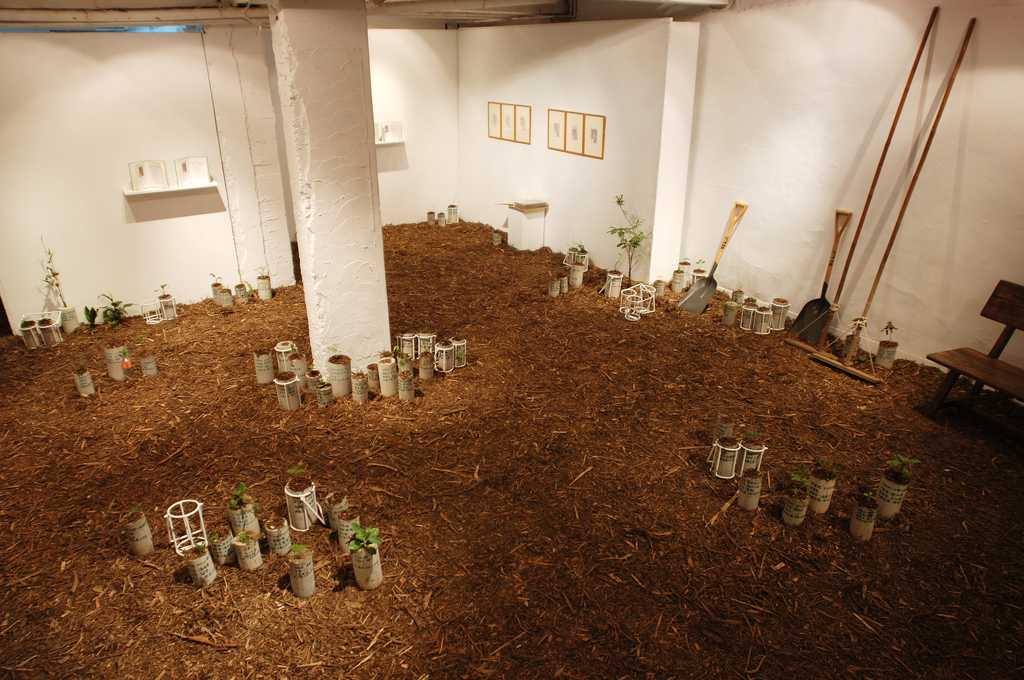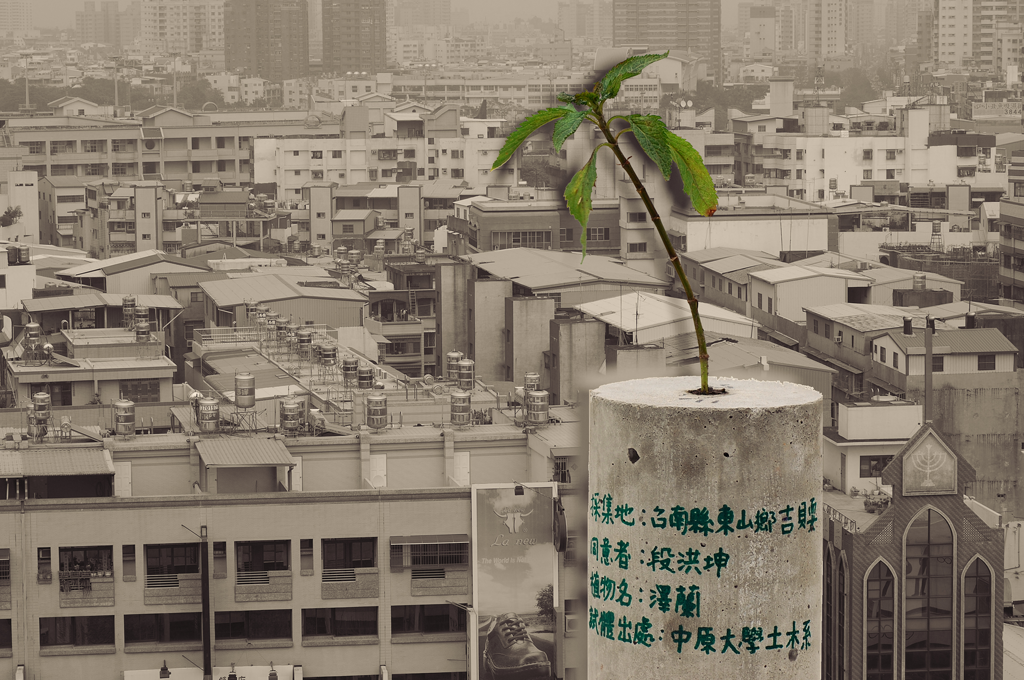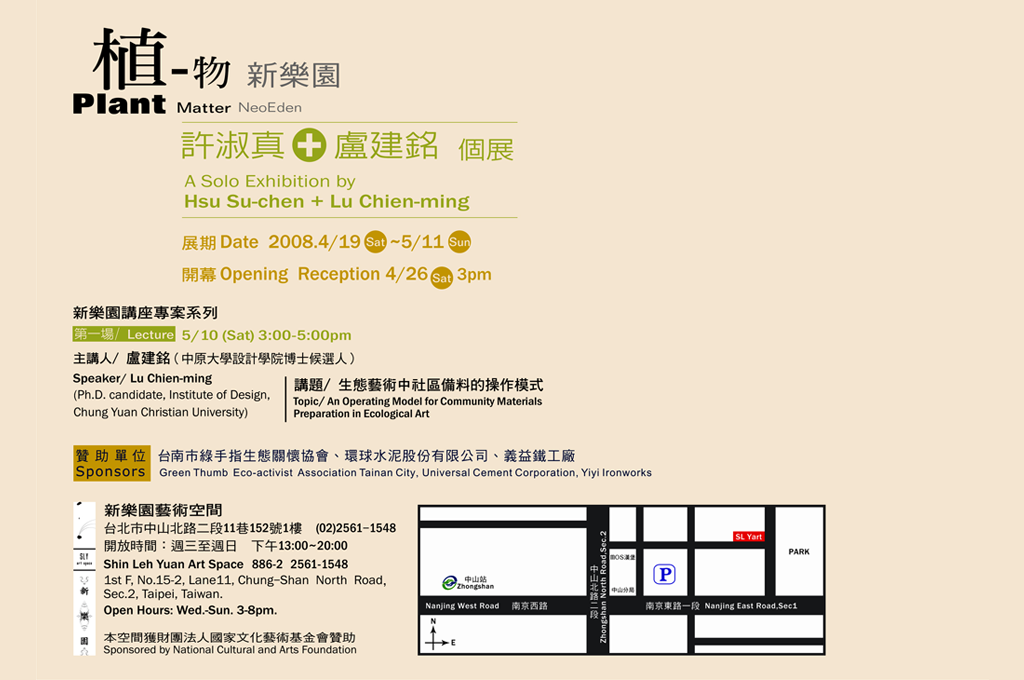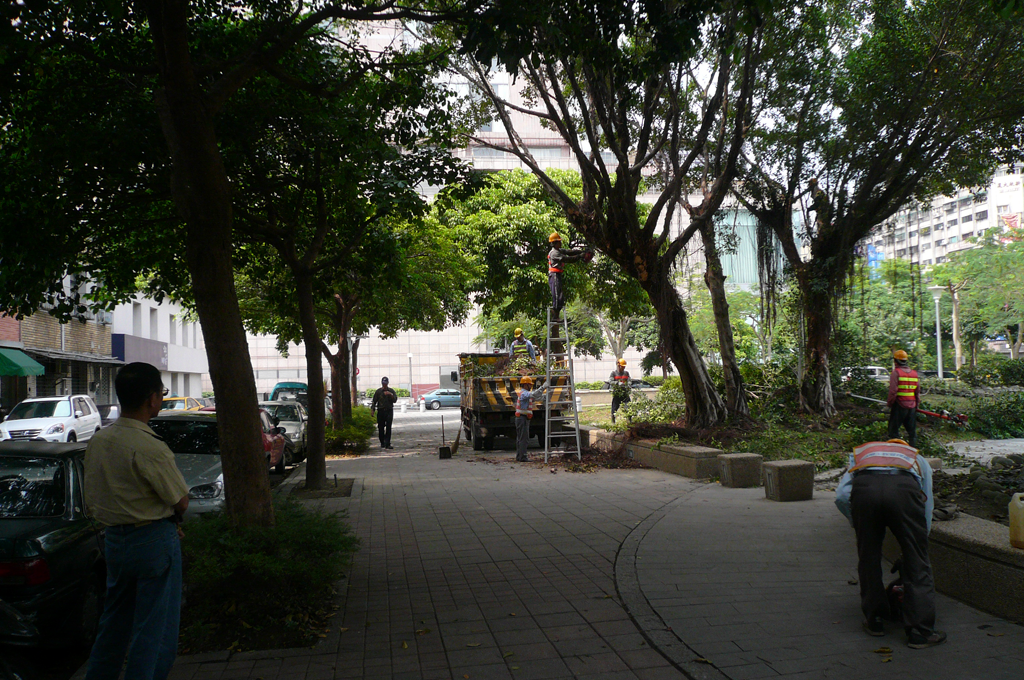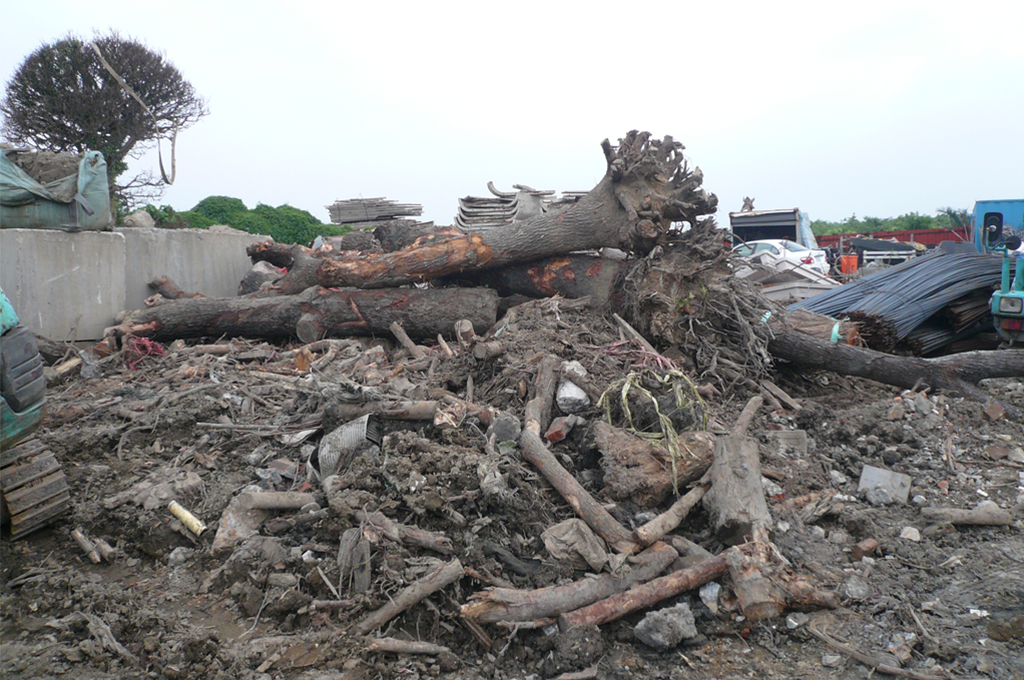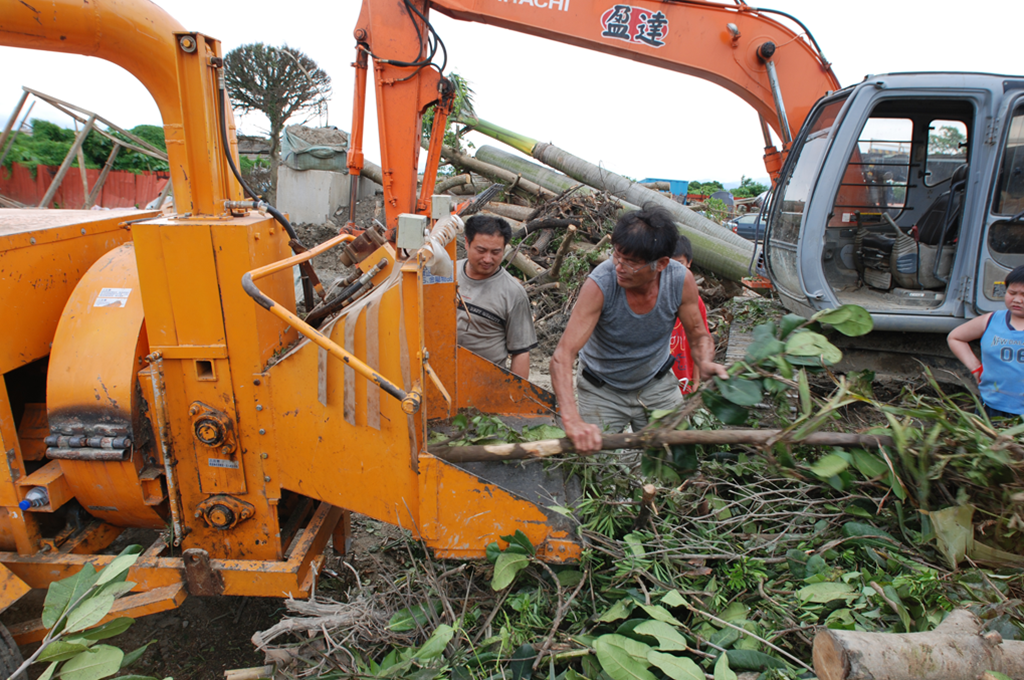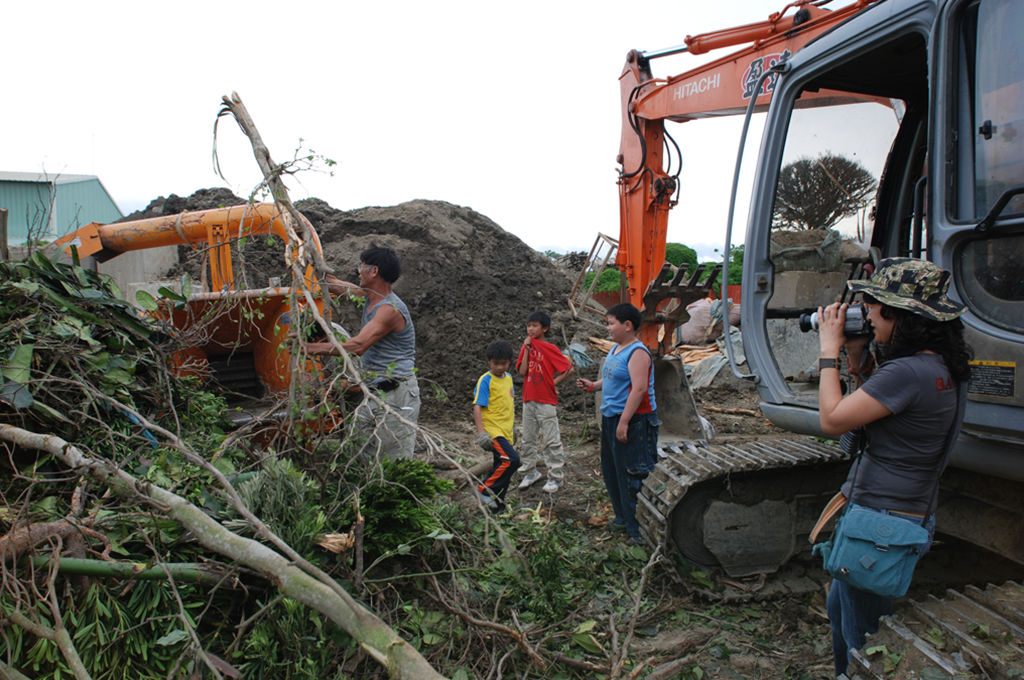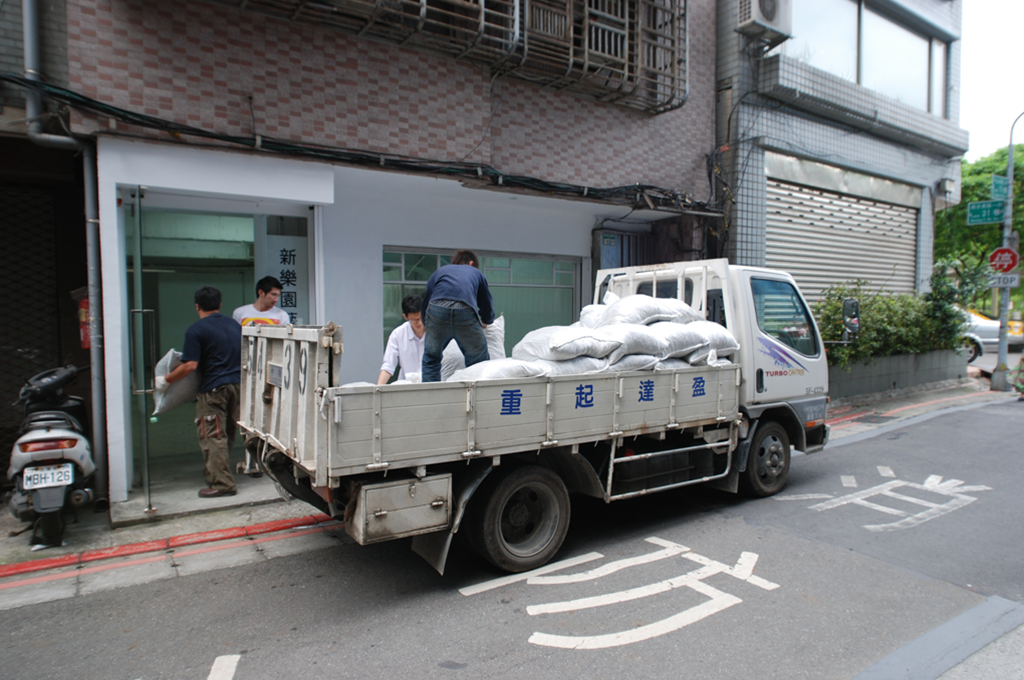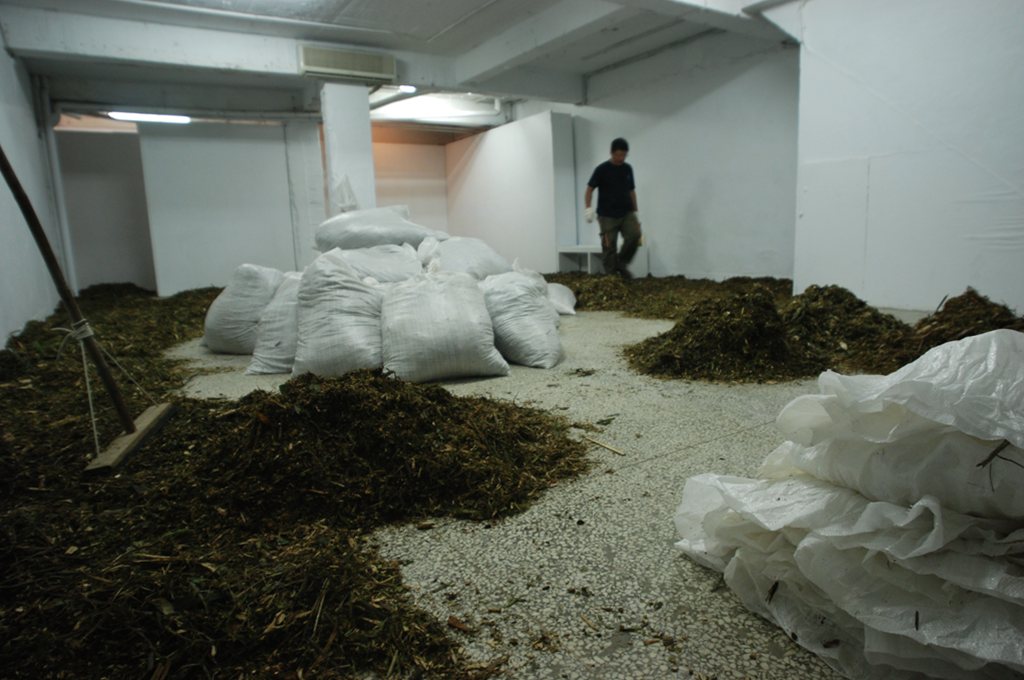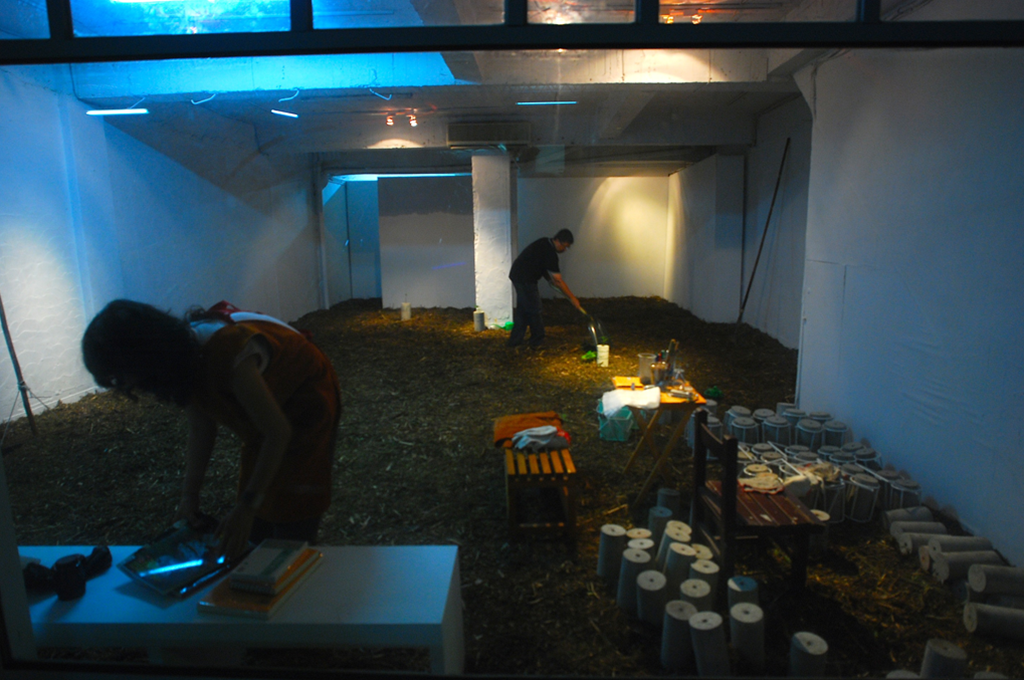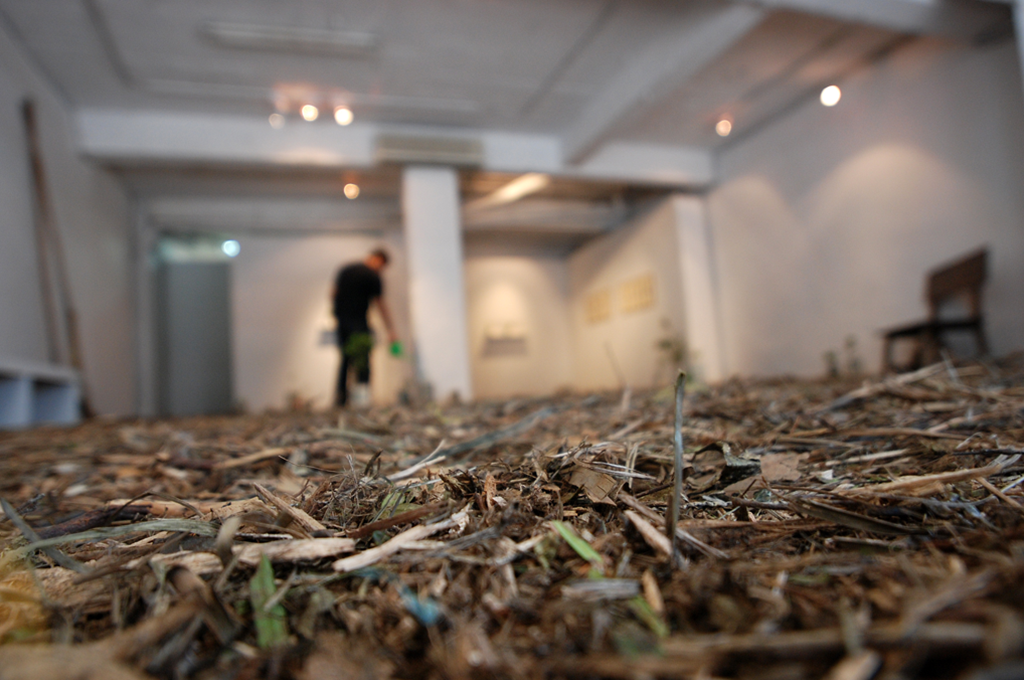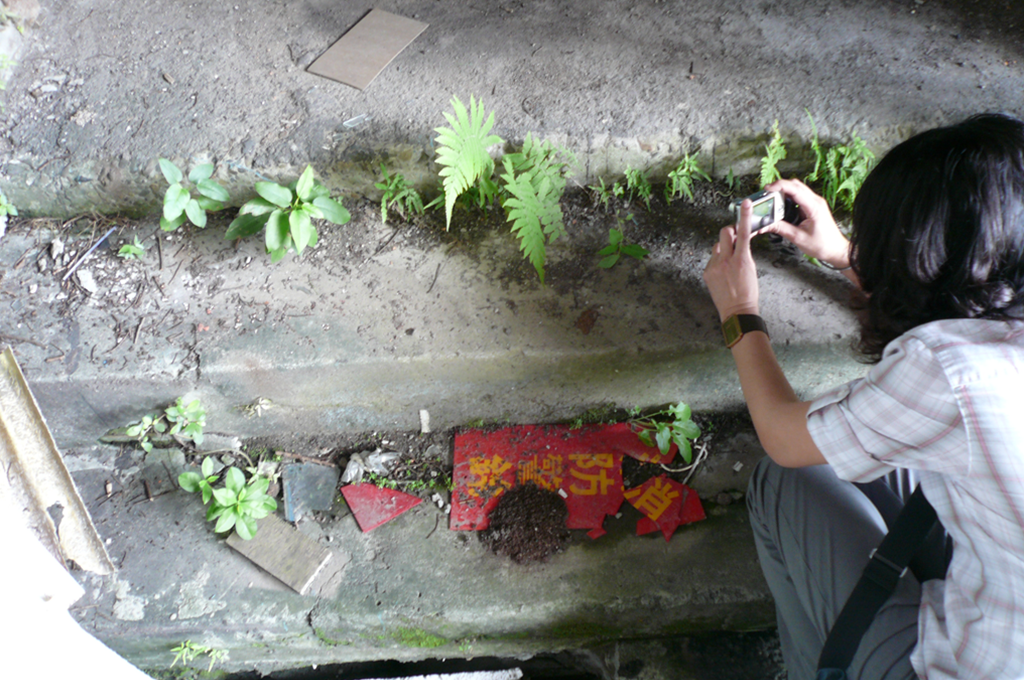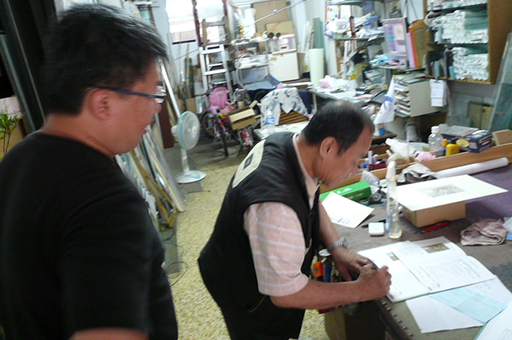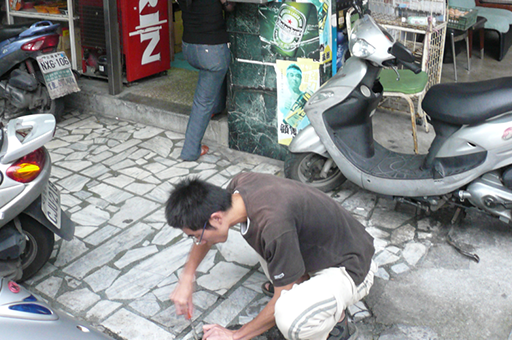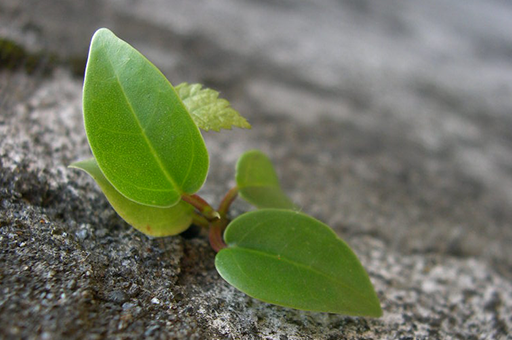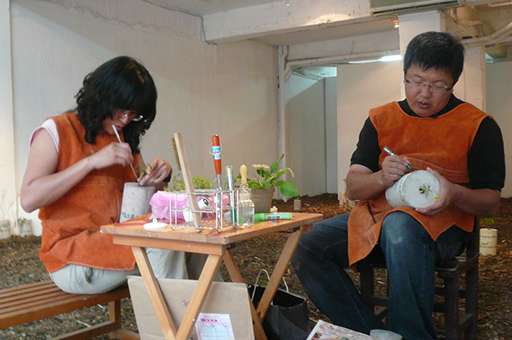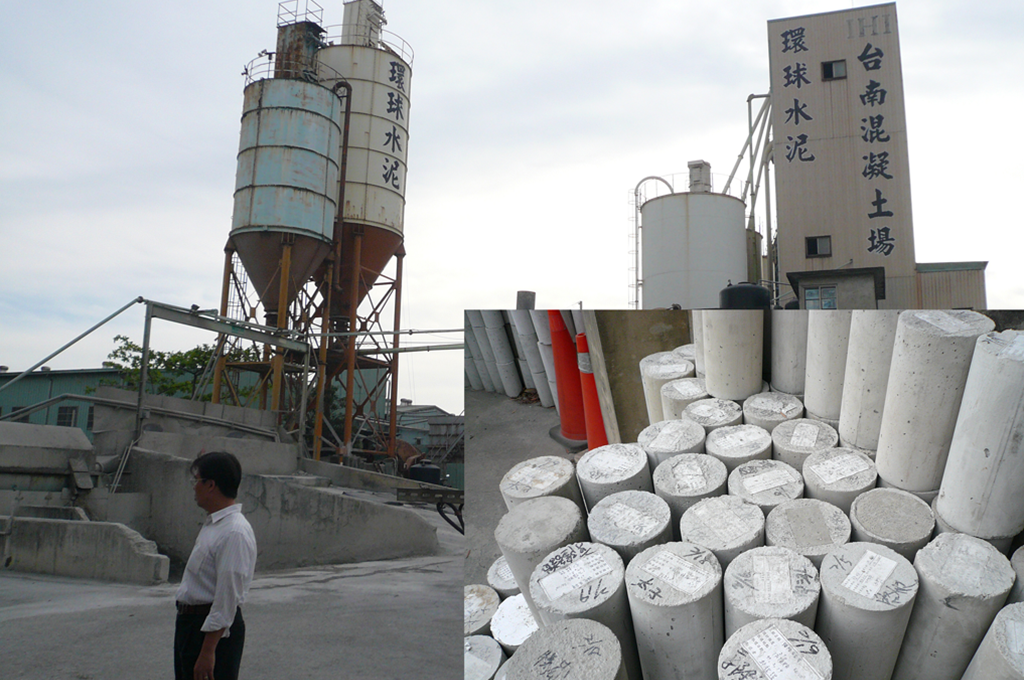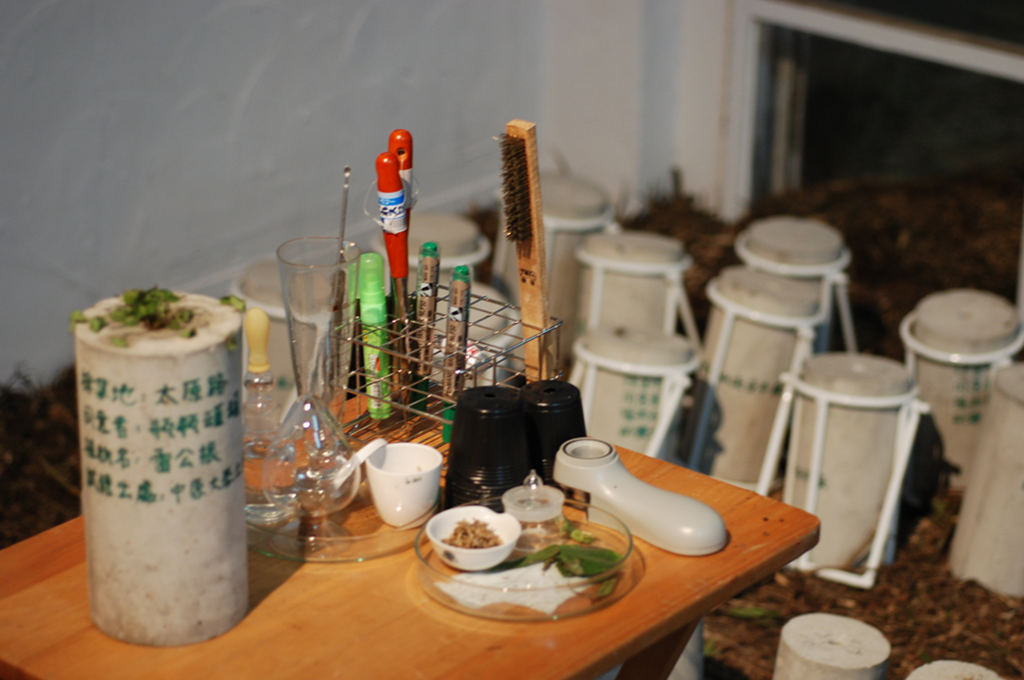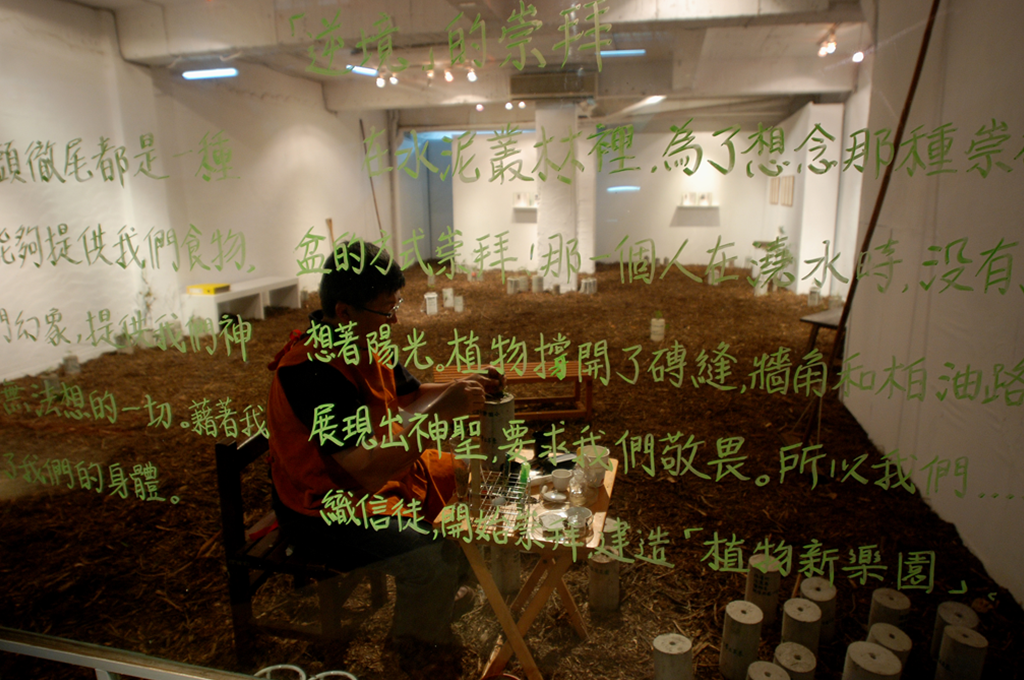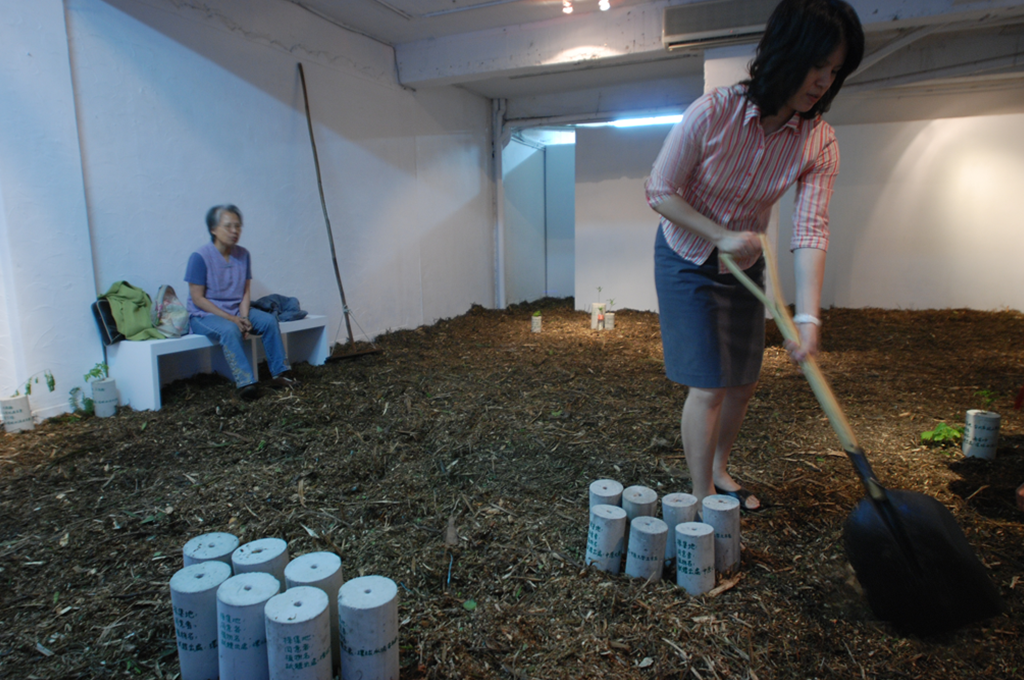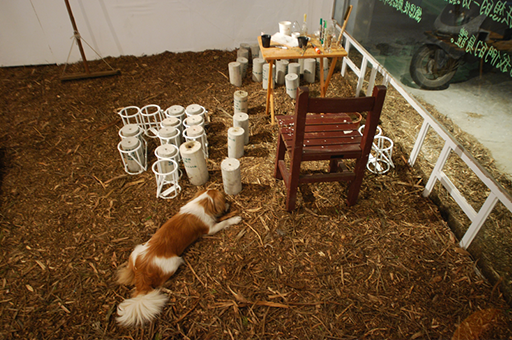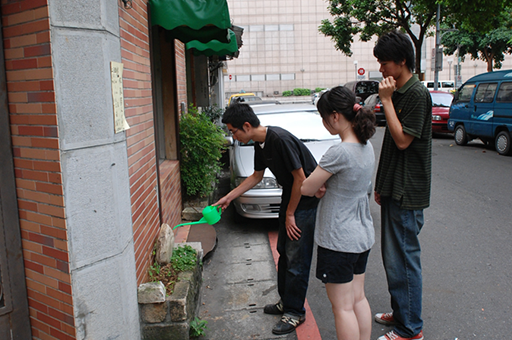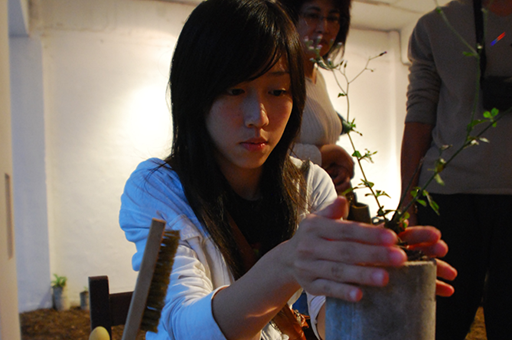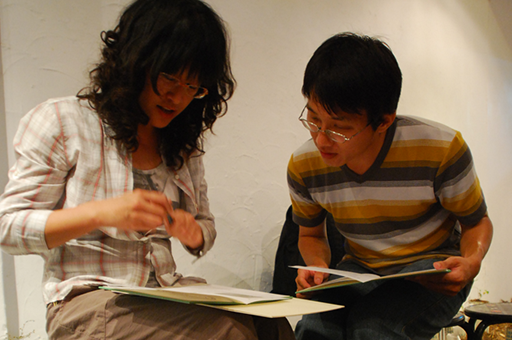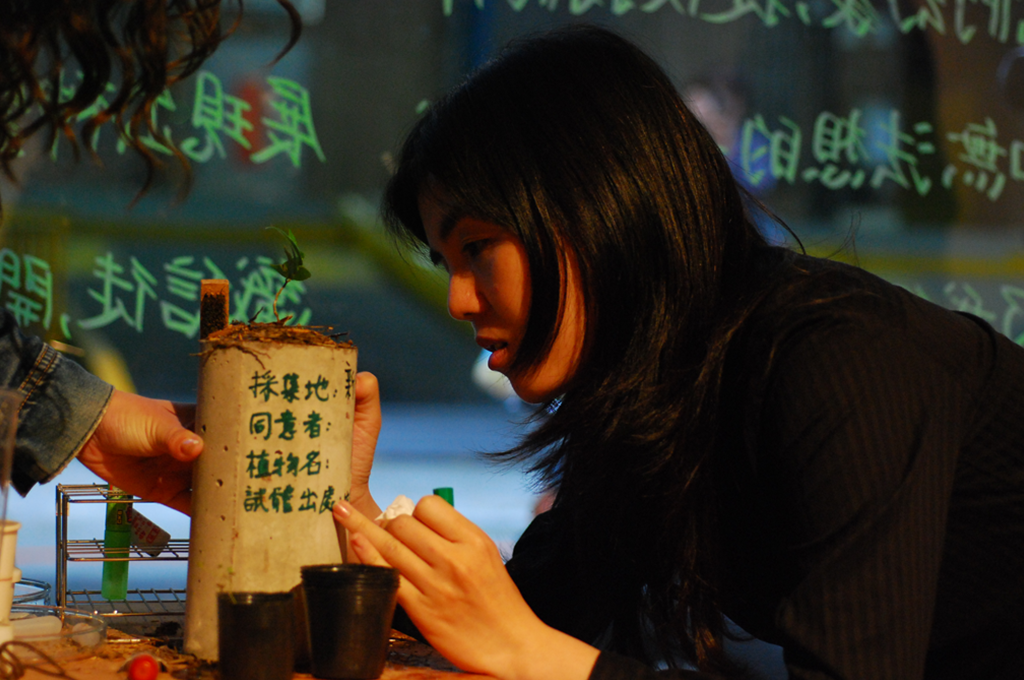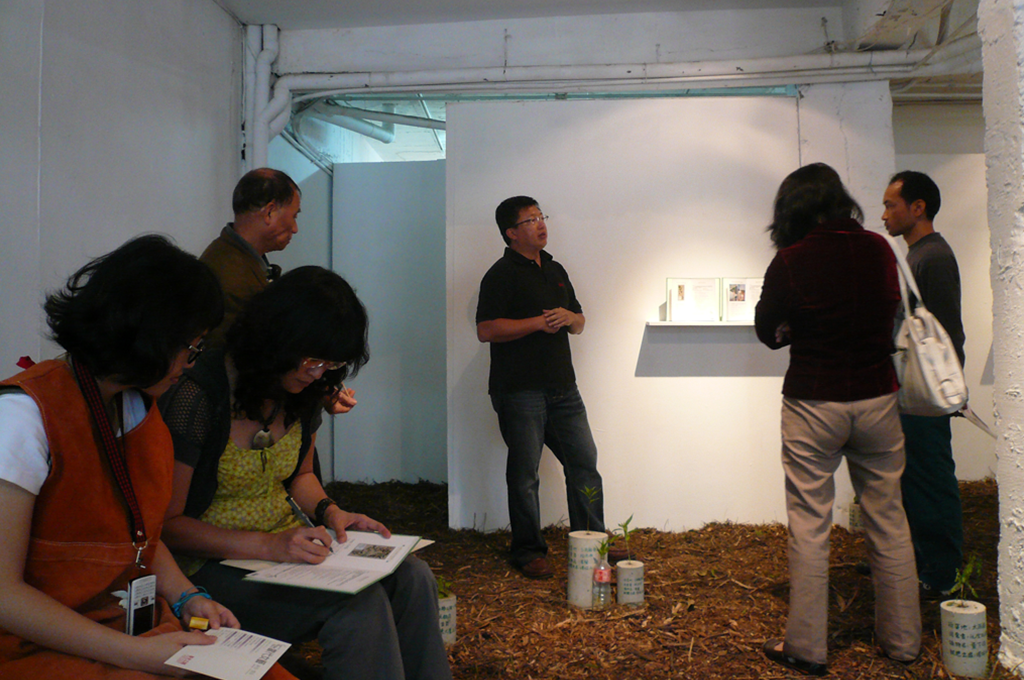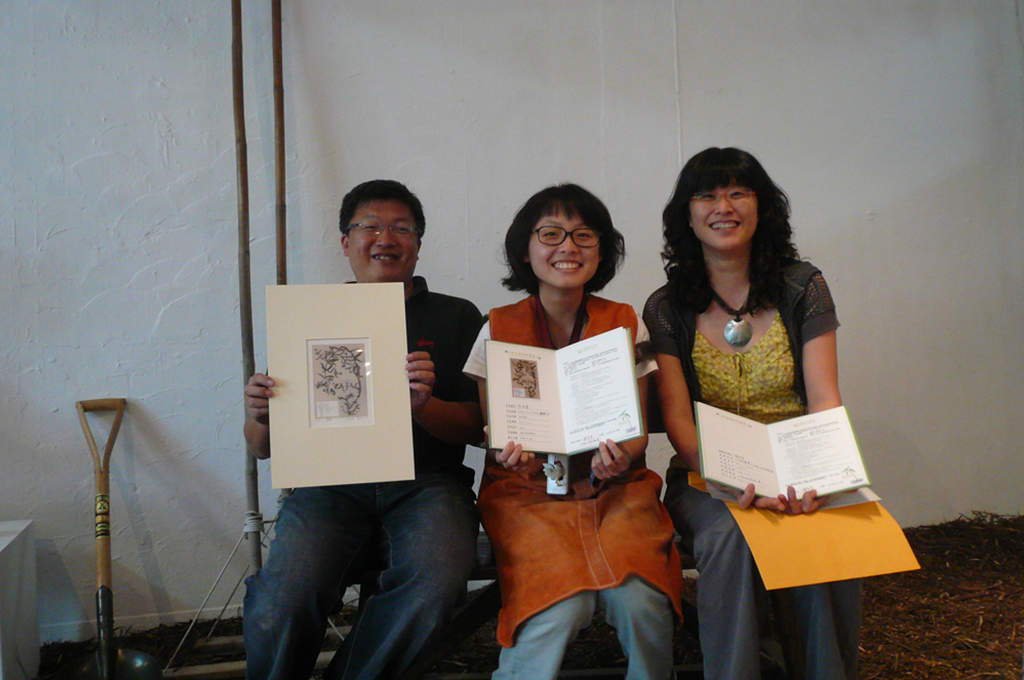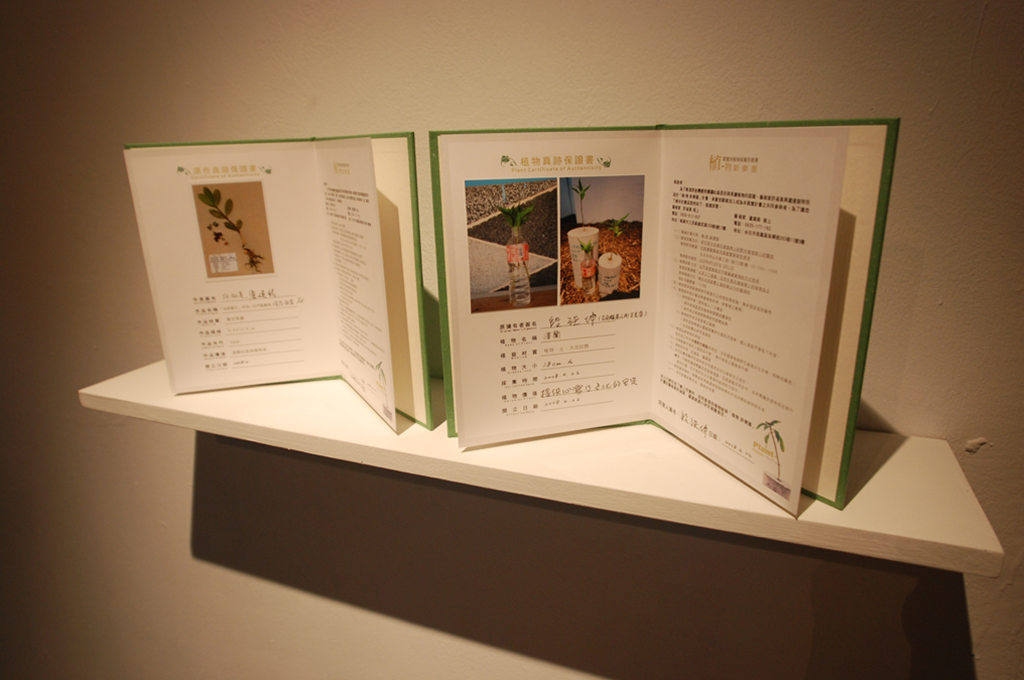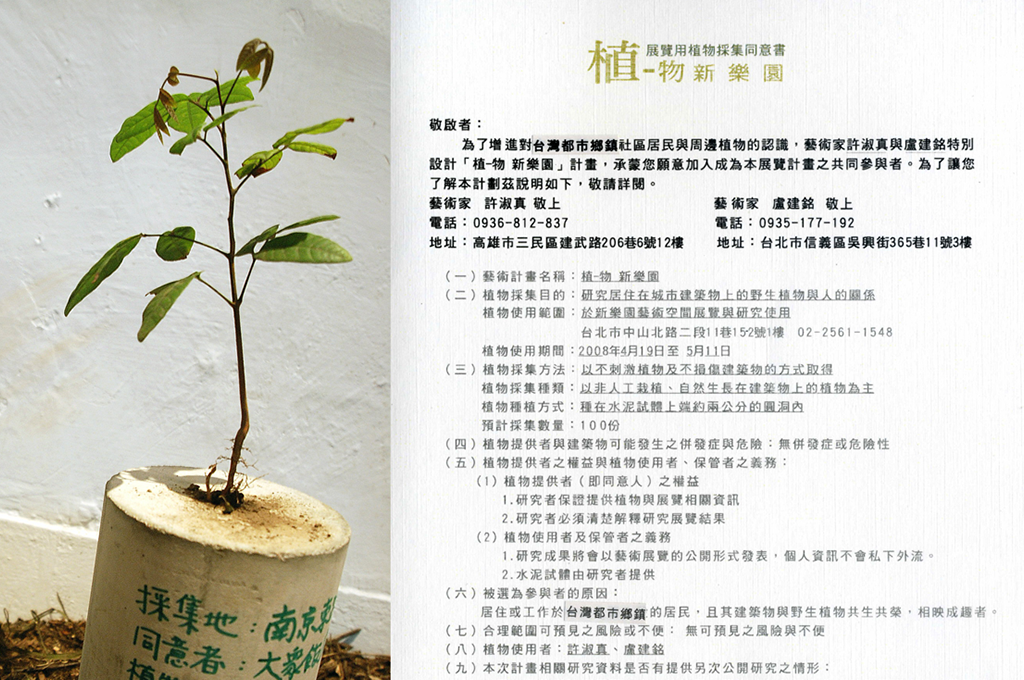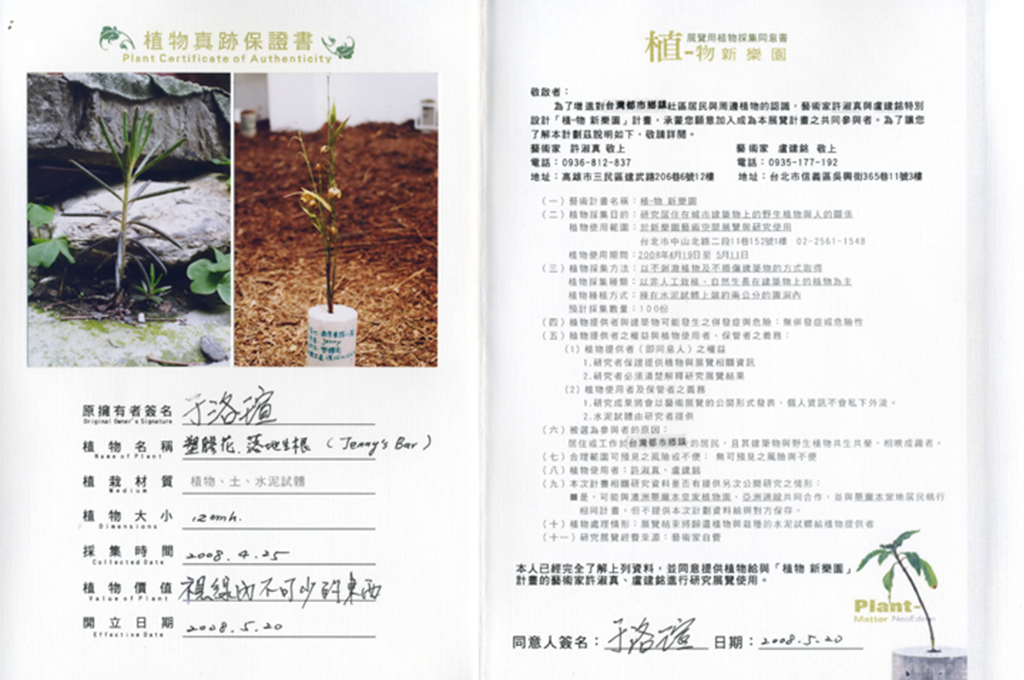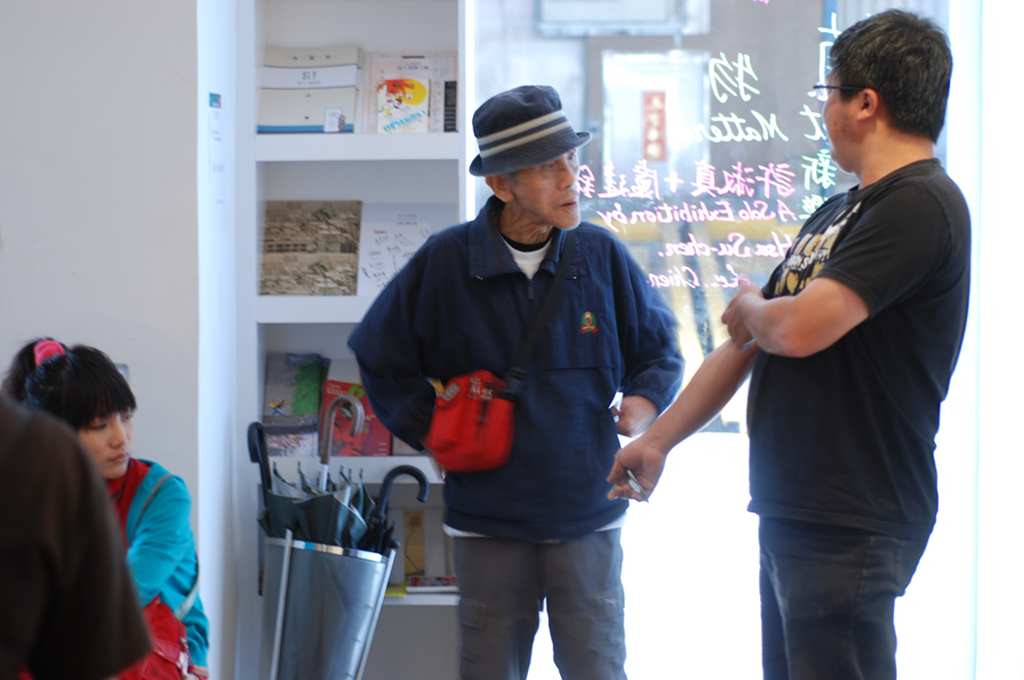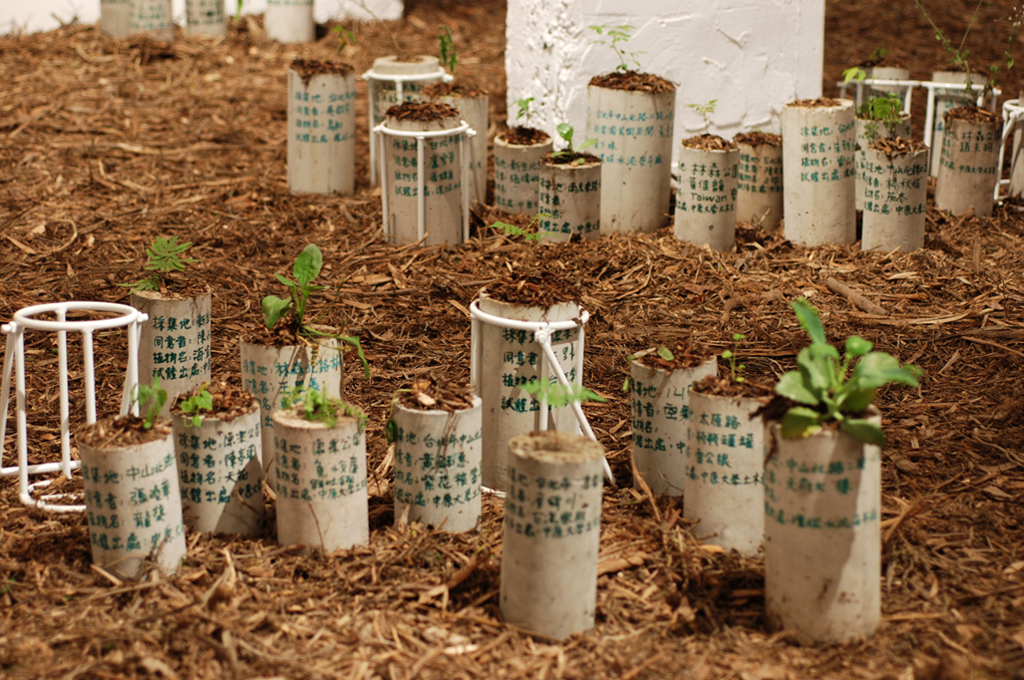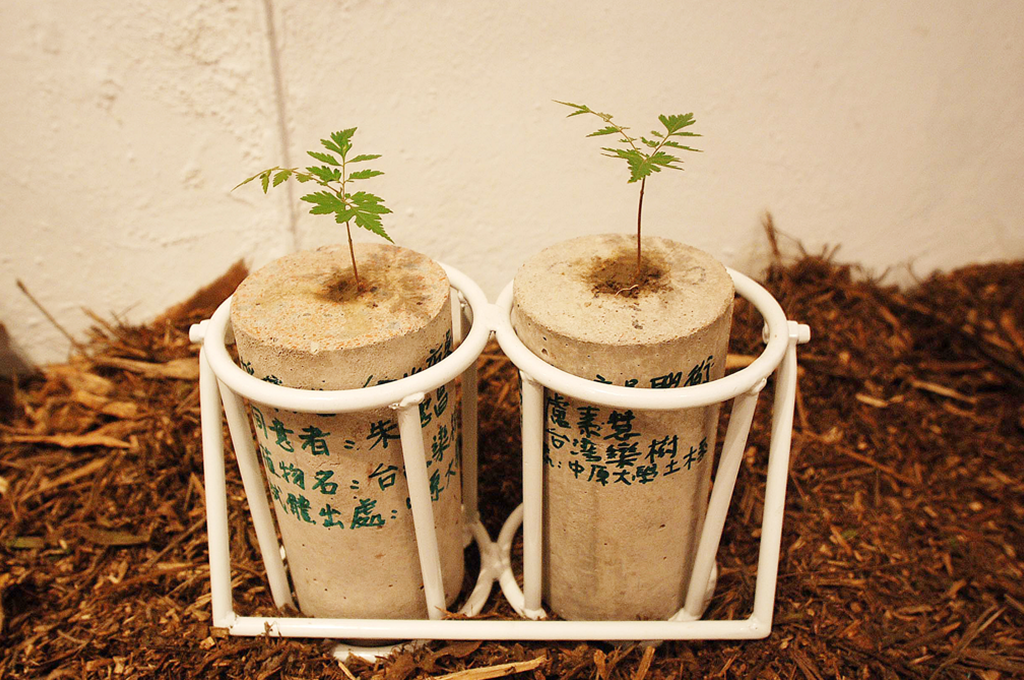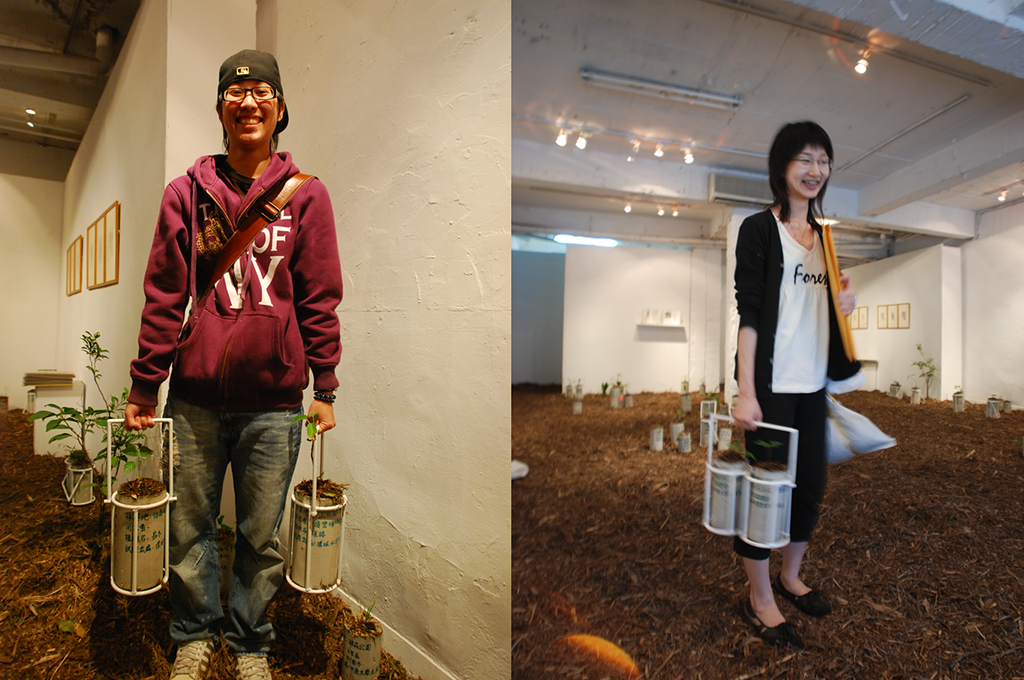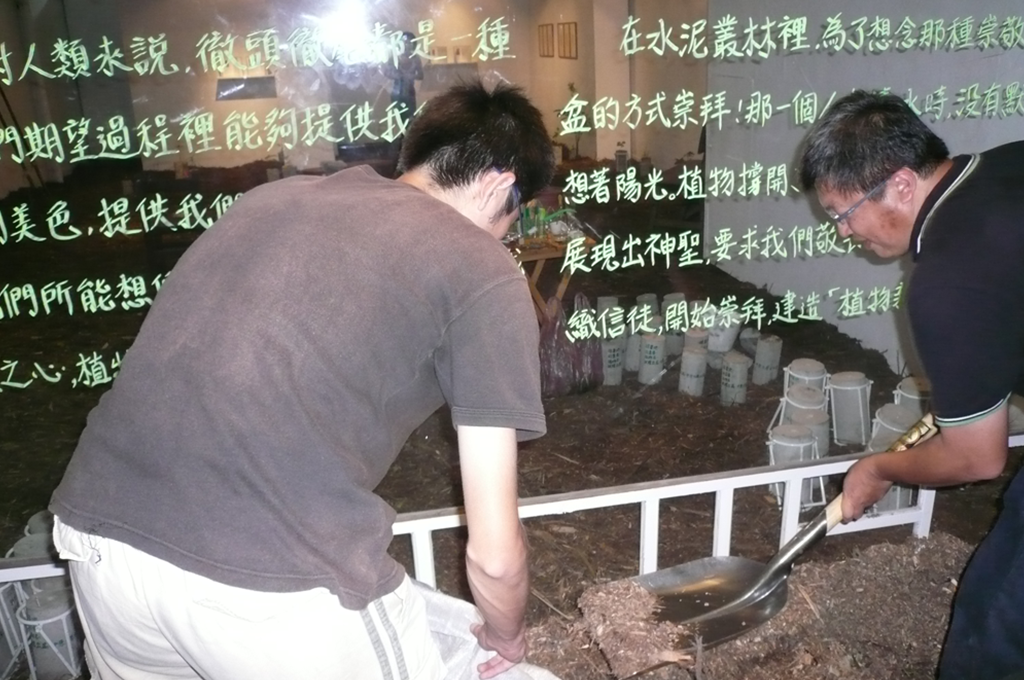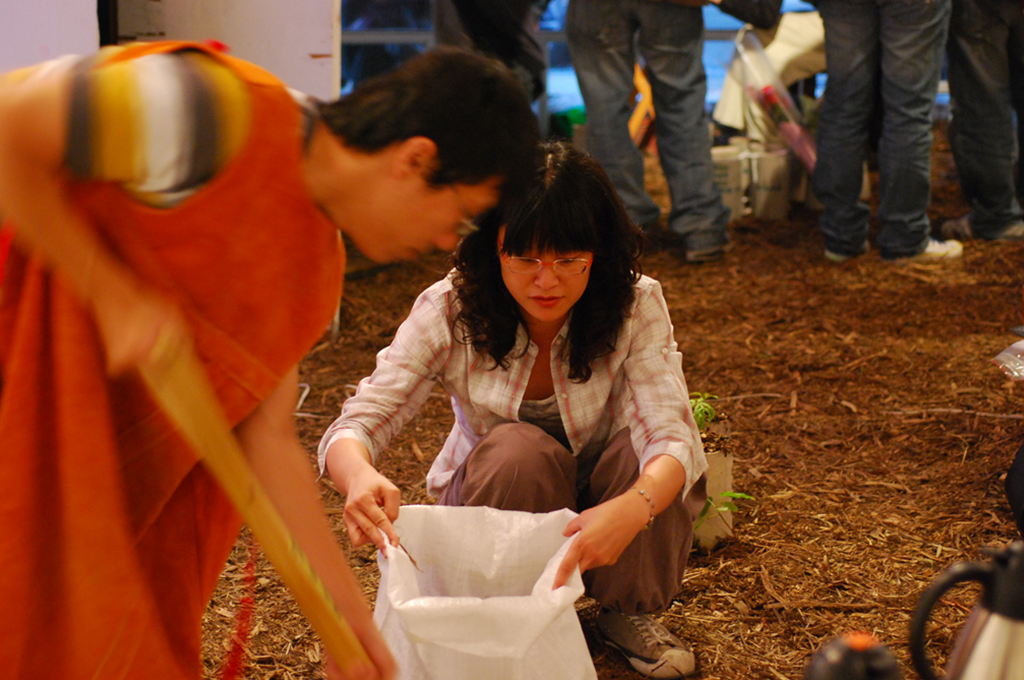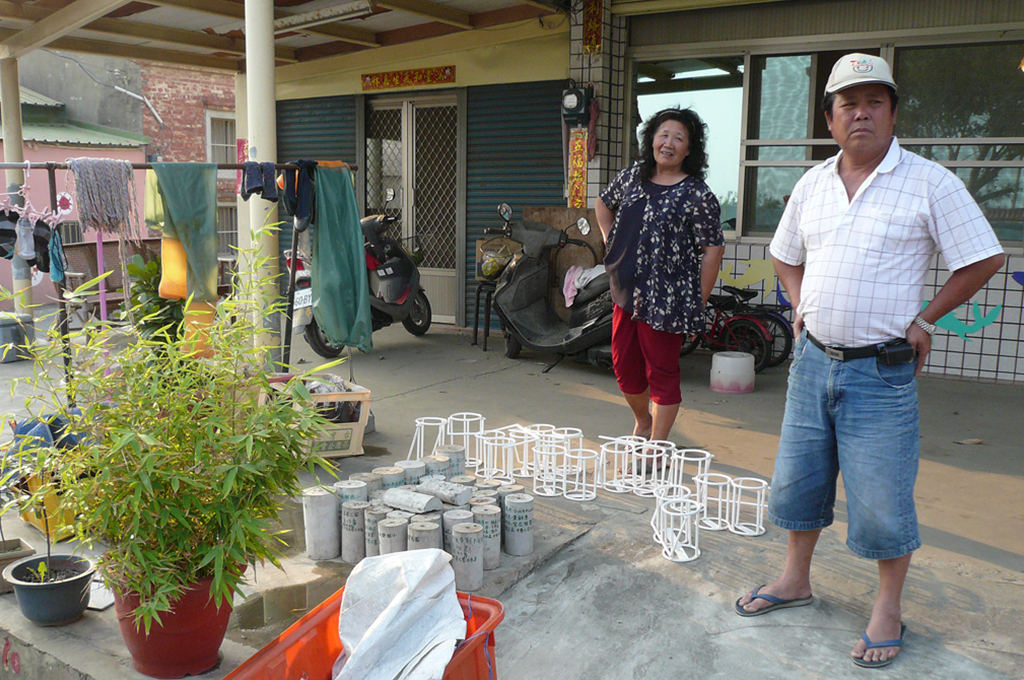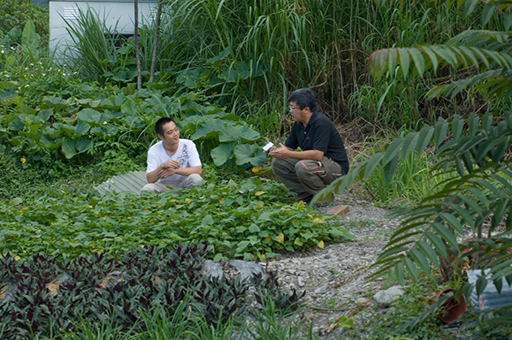植 – 物 新樂園計畫:
台北市 許淑真+盧建銘 個展
Plant-Matter NeoEden Project (Taipei)
A Solo Exhibition by Hsu Su-chen + Lu Chien-ming
2008 生態藝術計畫 碎木、水泥試體、逆境植物、版畫、保證書、栽種植物工具 大小依場地而定
Eco-Art Project , wood chips, cement specimens, adverse plants, block prints, guarantees, planting tools, size: depends on the place of exhibition
展覽日期:2008.4.19 (六) ~5.11 (日)
展覽地點:新樂園藝術空間,台北,台灣
開幕茶會:4.26 (六) 3pm
社區植物採集期:2008.4.19(六)~4.25(五)
Exhibition Location : Shin Leh Yuean Art Space, Taipei, Taiwan
Opening : 4.26 (Sat.) 3pm
Community Pick Date : 2008.4.19(Sat.)~4.25(Fri.)
「植」是一種崇拜
種植對人類來說,徹頭徹尾都是一種崇拜。我們期望過程裡能夠提供我們食物,提供我們美色,提供我們幻象,提供我們神聖,和我們所能想像和無法想像的一切。藉著我們的崇敬之心,植物進入我們的生活,啟示了我們的身體。
「逆境」的崇拜
而都市用水泥叢林卻逐漸將植物驅趕出去,但是因為想念那種崇敬,所以我們用一盆一盆的方式來崇拜!那一個人在澆水時,心裡沒有默念著敬辭?或是在搬動植物時,心裡沒有想著陽光?
除了這一盆一盆的崇拜,眾多的植物還是撐開了磚縫、牆角和柏油路,在逆境中展現出神聖,要求我們敬畏。所以我們必須組織信徒,開始崇拜,建造一個「植–物 新樂園」。
〈植–物 新樂園〉計畫的執行過程是試圖書寫植物於城市中的人文生態地理寓言, 從研究建築叢林中的逆境植物開始,進行社區互動模式的採集,以及對植物的鑑定與分類為貫穿其中的主要行動;再來是對都市廢材的創作實驗(如在〈植–物 新樂園—台灣台北市〉的計畫中大量使用水泥試體與行道樹修剪完的廢木),並落實在都市具生態設施與有機栽種的運作之中;而本計劃的執行內涵則是藉由社區運動與藝術人文的影響,由植物來當作觸媒,活絡城市居民之間的情感,以及進行生態思維的傳遞,來做為城市移民人口的隱喻以及對生命價值的再建立為主要精神。
〈植–物 新樂園—台灣台北市〉
水泥試體、植物標本、受測的人體檢體,都是同一個英文字Specimen,這也許是來自於這個計畫的巧合,還是…冥冥註定。
這一切先從來自台灣台南縣東山鄉吉貝耍村的神性植物澤蘭開始(註一),剛被族人用「換青」儀式加持過的澤蘭,因〈植–物 新樂園〉展覽被帶來台北,並和我們進行著交換的儀式,這位西拉雅族人將獲得我們的〈地表繁衍--石門鄉富貴角〉植物標本的版畫作品,並且與我們互相簽訂同意書。(註二)
在這一個月的展期裡,我們持續探訪社區居民,尤其是外縣市來的移民與地區性產業的人們,邀請他們加入這個計畫,而展覽現場就是來自於他們採集長在都市夾縫中的植物,這些約100株的植物被我們種在為建築工程測試而被廢棄的水泥試體上,居民也藉此收到藝術家的版畫作品。(註三)
而展場所鋪上的碎木,則是特意將台北市因修剪行道樹所廢棄的樹木,打成可以成為公園人行道鋪面與以及植栽肥料的大小,而大量調入中山區行道樹以樟木為主的10公分厚的木屑鋪面,也讓展場形成如具森林芬多精的味覺氛圍。
這些展場上的所有物資,將都會在展覽結束之後散落在社區裡:如讓一般居民也可以用微薄的代價收藏起藝術品的「啟動社區典藏制度」,讓這些植物版畫的收藏與展示的範圍,形成一個社區大畫廊;而66袋的碎木收藏則散放在一般居家植栽、學校的生態步道(如中原大學景觀系)、藝術文化機構(如台北國際藝術村、文建會)、外縣市的社區(如嘉義縣的四股社區)、以及有機農園裡(如宜蘭有機蔬菜農園),而特別設計的「蹓植物試體」提籃(仿世紀種源庫的放種子瓶的架子),則方便民眾在戶外蹓植物與健身,這些試體提籃也與植物試體一樣散放在社區之中。
註一:在台灣平地原住民平埔族中的西拉雅族部落,就數這裡的原住民血統最純正,被漢化的程度最少。
註二:同意書分成兩個部份,一是觀眾或社區居民同意捐贈他們的植物給與藝術家展覽,而同意書的書寫範本模仿史丹佛人類學博士生陳叔倬的研究用人體檢體採集同意書格式(其研究目的為以族群遺傳學方法研究臺灣西拉雅族的起源與遷徙,並以遵從「原住民族基本法」第二十一條之規定,與吉貝耍簽署研究倫理平等條約,以維護吉貝耍的集體權益),這個部份的創作已獲得陳叔倬本人同意;另一份藝術家作品證明書以及居民的植物真跡證明書的格式則為模仿商業畫廊的藝術作品保證書。
註三:〈地表繁衍--石門鄉富貴角〉的植物標本的數位版畫系列作品共有六張,有小飛楊草、天人菊、天花、琼崖海棠、台灣蒲公英、鱧腸,這是在2007年9月在台灣本島最北端的石門鄉富貴角的所採集而成的一百種濱海植物標本所精選出來的。
"Plants" are a form of worship
From beginning to end, growing plants is a form of worship. We expect this process to provide us with food, with beauty, with illusion, with sacredness, and with everything that we can imagine and cannot imagine. By means of our reverent hearts, plants enter our lives and awaken our bodies.
Worship of Adversity
Although the urban cement jungle has gradually expelled plants, our longing for that kind of reverence has inspired us to worship using potted plants! Does anyone fail to silently contemplate words of respect when watering? Who does not think of where the sunlight will be when moving a plant?
Beyond our worship of potted plants, countless plants grow in the cracks between bricks, at the corners of walls, or in asphalt roads. These plants manifest the sacred in the midst of adversity, asking for our veneration. We must therefore organize believers, begin worship, and create a "Plant–Matter NeoEden." (Lu Chien-ming)
The Plant – Matter NeoEden project is an attempt to write a parable on plants grown in an urban environment. Starting with research into adverse plants in the forest of buildings, I focused on means to interact with the community with regards to gathering a collection of plants. Work was also carried out to identify and categorize the plants. The next step was to engage in creative experiments with urban refuse (as spotlighted in the Plant – Matter NeoEden – Taipei City, Taiwan project that employs cement specimens and clippings from trees along sidewalks). An attempt was then made to use organic means to foster an ecosystem within the city. The significance of carrying out this project involves community activity and the arts. Plants are used as a medium to invigorate the emotional state of people in the city and to foster a concept of passing along ecological concepts. This serves as a metaphor for urban migrants and re-establishes an important spirit in recognizing the value of life.
<Plant – Matter NeoEden – Taipei City, Taiwan>
Cement specimens and plant specimens both use the word “specimen,” which is frequently associated with the use of the same word when speaking of the human body. Perhaps this is just a coincidence in this project. On the other hand, perhaps it is not!
Everything started with a magical Eupatorium lindleyanum Dc. from Chipeishua Village in Tungshan Township of Tainan County (Note 1). Used in an aboriginal ritual, this Eupatorium lindleyanum Dc, known as the Eupatorium formosanum Hayata, was brought to Taipei to be displayed in the Plant – Matter NeoEden exhibition. We engaged in a ceremony with members of the Siraya tribe to exchange a block print of a plant specimen from The Fertile Surface of the Earth – Rich Point, Shi Men Village for the Eupatorium lindleyanum Dc. They also signed a letter of consent with us (Note 2).
During the one-month exhibition, we paid visits to community residents, especially people who had migrated to the area from other parts of Taiwan as well as people working there. We invited them to participate in the project. We put on display plants that were collected from various crevices in the area. We planted about 100 sprigs of these plants in concrete specimens that had been discarded in the course of constructing buildings. In the process, many residents received a number of block prints from the artist (Note 3).
Wood chips were spread along the floor of the exhibit area. The wood chips were made expressly from branches cut down from trees along sidewalks throughout Taipei City. These were processed into chips that could be used to make pathways through parks and fertilizer for other plants. The chips were used to fill in a pathway in the Chungshan District of the city where many camphor trees grow. The chips form a 10-centimeter thick base, giving the area the feeling of a forest.
All of the objects used in the exhibit will be distributed throughout the community after the exhibit is over. Neighborhood residents will be able to collect these modest items, providing a foundation for a neighborhood collection system. All of the block prints of the plants will ultimately form the backbone of a community gallery. Meanwhile, the 66 bags of wood chips will be distributed throughout the neighborhood to be used in gardens, eco-trails in schools (such as Chung Yuan Christian University’s Department of Landscape Architecture), arts and culture institutions (such as the Taipei Artist Village and the Council for Cultural Affairs), communities outside of Taipei (such as the Szeku neighborhood in Chiayi County), and organic gardens (such as organic vegetable farms in Ilan). In addition, specially designed baskets for Plant-Cement specimens will make it easy for residents to carry out plants and to exercise. These baskets will also be distributed throughout the community
Note 1: The Siraya village is home to one of Taiwan’s indigenous Pingpu tribes that live in the plains. The blood line of the members of this tribe is thought to be very pure, having been hardly impacted by the ethnic Han bloodline.
Note 2: The consent form has two portions. The first involves the public or neighborhood residents agreeing to donate their plants to the artist for the exhibit. The consent form is modeled on the human specimen collection consent form designed by Stanford University doctor Shu-Juo Chen in her population genetics research on the ancestry and migration of the Siraya. The form also conforms to regulations under Article 21 of the Indigenous People’s Basic Law and the equality treaty signed with the Gabua-Swa that protects their collective interests. Shu-Juo Chen has granted her consent to this part of the art project. The other portion of the consent form is an artists’ certificate and a certificate for residents that guarantee’s the authenticity of the plants. This is based on art work certificates used at commercial galleries.
Note 3: The<The Fertile Surface of the Earth – Rich Point, Shi Men Village>plant specimen block print series has six images, Euphorbia thymigolia, Gaillardia pulchella, Mudia maderaspatana, Calophyllum inophyllum L., Taraxacum Formosanum Kitamura, and Eclipta prostrata. These plants were collected from Rich Point in Shi Men Village at the northernmost tip of Taiwan and form part of a broader group of 100 specimens of coastal plants.
Lecture: An Operating Model for Community Materials Preparation in Ecological Art
